engine AUDI A4 2016 Service Manual
[x] Cancel search | Manufacturer: AUDI, Model Year: 2016, Model line: A4, Model: AUDI A4 2016Pages: 278, PDF Size: 70.26 MB
Page 115 of 278
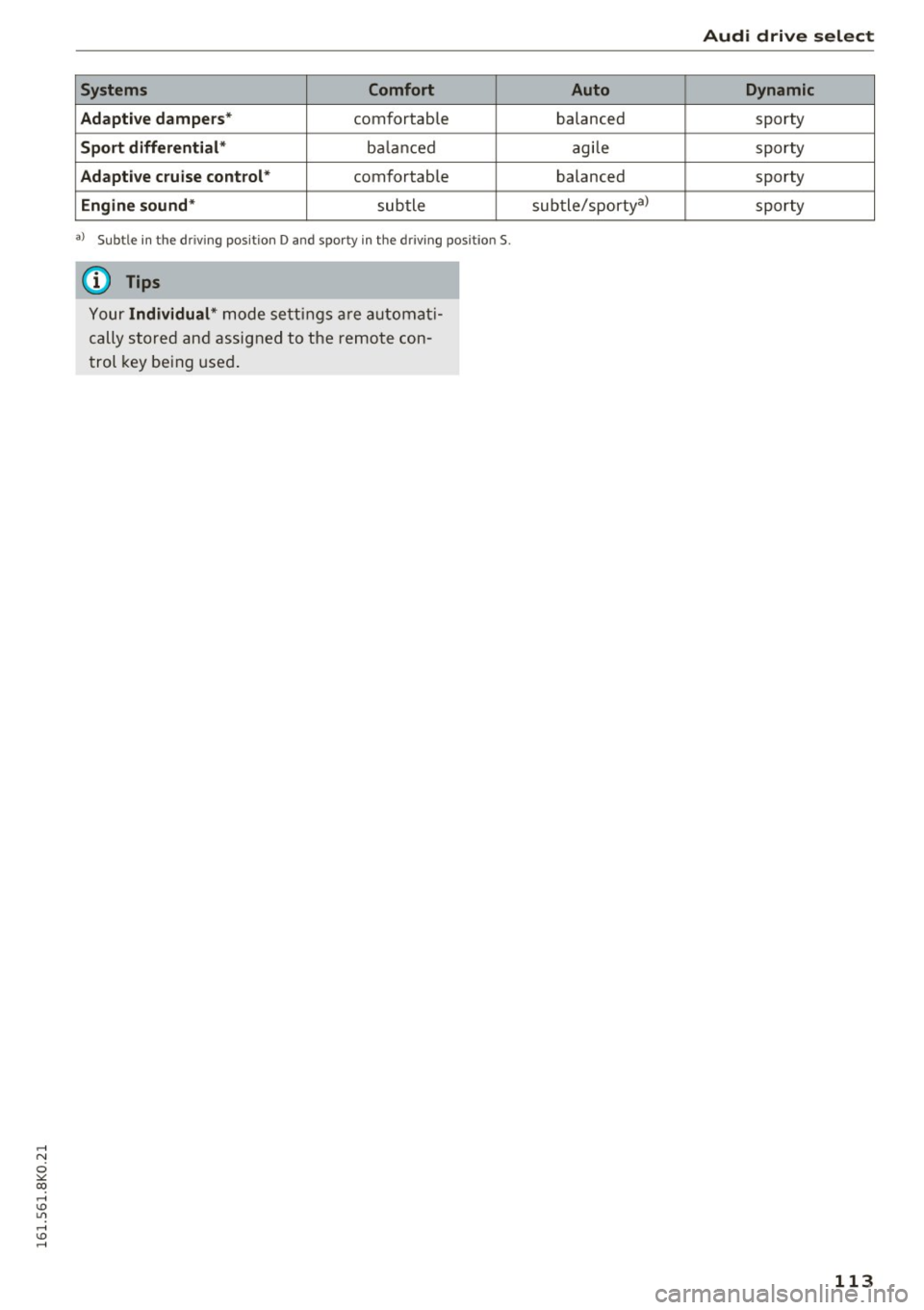
..... N
0 ::..:: co .....
Adaptive dampers*
comfortable
Sport differential * balanced
Adaptive cruise control* comfortable
Engine sound* subtle
a) Subtle in the driv ing pos ition D and sporty in the driv ing position S.
(D Tips
Your Individual* mode settings are automat i
cally stored and assigned to the remote con
trol key being used .
Audi drive select
Auto Dynamic
balanced sporty
agile sporty
balanced sporty
subtle/sportyal sporty
113
Page 178 of 278
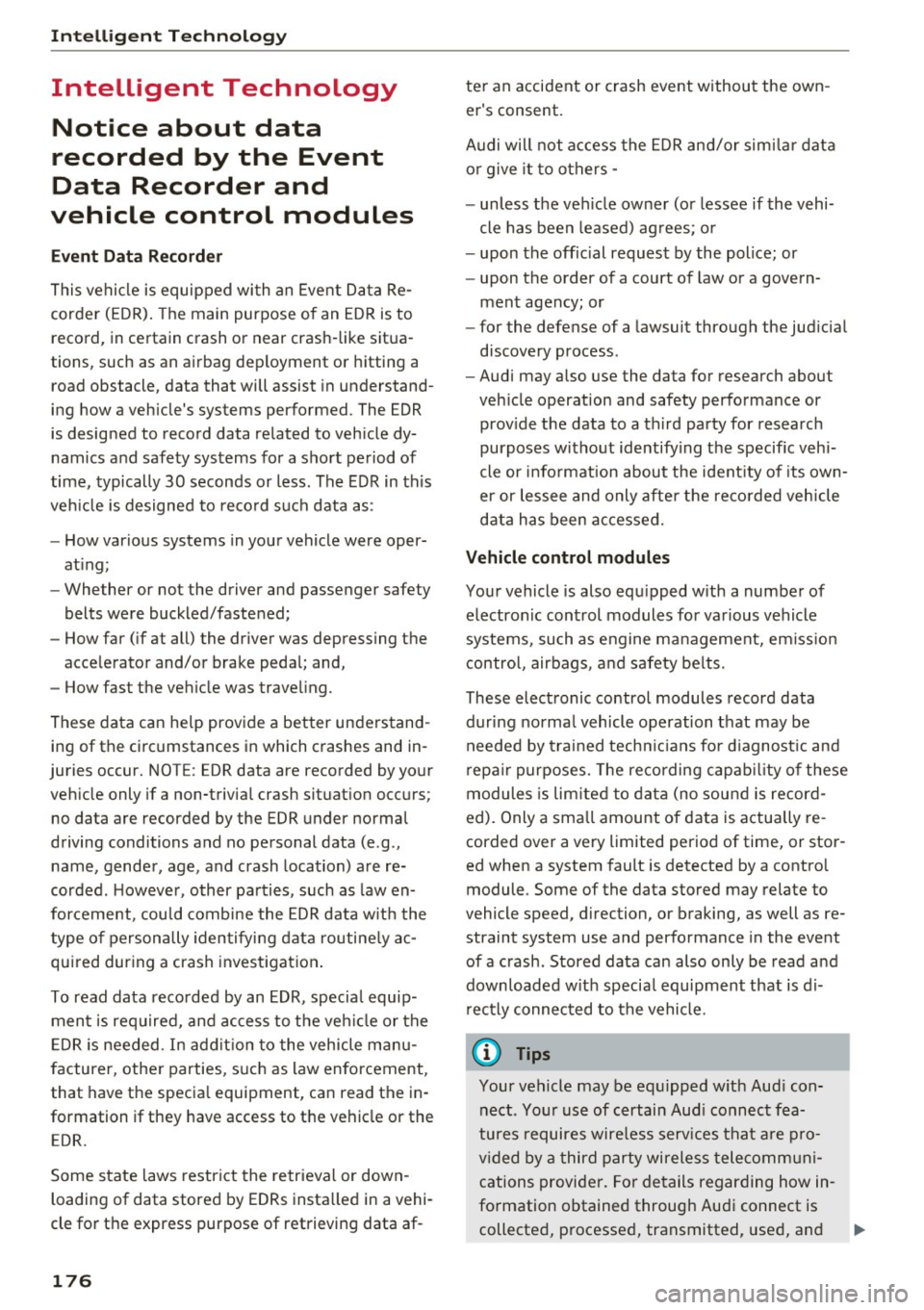
Intelligent Technology
Intelligent Technology
Notice about data
recorded by the Event
Data Recorder and
vehicle control modules
Event Data Re corder
This vehicle is equipped wi th an Event Data Re
corder (EDR) . The main purpose of an E DR is to
record, in certain crash or near crash -like situa
tions, such as an airbag deploym ent or h itting a
road obstacle, data that will assist in understand
ing how a veh icle 's systems performed . The EDR
is designed to record data related to veh icle dy
namics a nd safety systems for a sho rt period of
time, typically 30 seconds or less . The E DR in this
veh icle is designed to reco rd s uch data as :
- How various systems in your vehicle were oper
at ing;
- Whether or not the driver and passenger safety
belts were buckled/fastened;
- How far ( if at all) the driver was depressing the
acce lerator and/or brake peda l; and,
- How fast the ve hicle was trave ling.
These data can help provide a better understand ing of the ci rc u mstances in which c rashes and in
juries occur. NOT E: EDR data are recorded by yo ur
veh icle only if a non-trivia l crash situat ion occurs;
no data are recorded by the EDR under normal
driving conditions and no personal data (e .g .,
name, gender, age, and crash location) a re re
corded . H owever , other pa rties , such as law en
forcement, cou ld combine the EDR data w it h the
type o f person ally identifyi ng dat a routine ly ac
qu ired dur ing a crash invest igat ion .
To read data reco rded by an EDR, specia l equip
men t is req uire d, and access to the veh icle or the
E DR is needed. In ad dition to the vehicle manu
facturer, other parties, s uch a s law enforcement,
that have t he specia l equipment, can read the in
formation if they have access to the vehicle or the E DR.
Some s tate laws restrict the re trieva l or down
loading of data stored by ED Rs insta lled in a vehi
cle fo r the express purpose of retrieving data af -
176
ter an accident or crash event withou t the own
er 's consent.
Audi will not access the EDR and /or sim ilar data
o r g ive it to others -
- unless t he ve hicle ow ner (o r lessee if the vehi
cle has been leased) ag rees; o r
- upon the offic ial request by the police; or
- upon the order of a court of law or a govern-
ment agency; or
- for the defense of a lawsuit through the jud icia l
discovery process.
- Audi may also use the data for research about
veh icle operation and safety perfo rmance or
prov ide the data to a th ird party for research
purposes w itho ut identify ing t he specific vehi
cle or info rmat ion about the ident ity of its own
er or lessee and only afte r th e re co rded vehicle
d ata has been a ccessed.
Vehicle control modules
You r vehicle is also equ ipped with a number of
e lectronic cont rol modules for va rious vehicle
syste ms, such as engine ma nagement, em iss io n
contro l, air bag s, a nd safety be lts.
These electronic control modules record data
dur ing norma l vehicle operation t hat may be
n eeded by tra ined techn ic ians for d iagnost ic and
r ep air pur poses. The re cording capab ility of these
modules is lim ited to dat a (no sou nd is recor d
ed). Only a sma ll amount of data is actually re
corded over a very limited period of time, or stor
ed when a system fault is detected by a contro l
module . Some of the data stored may relate to
vehicle speed, direction, or braking, as well as re
straint system use and performance in the event
of a crash . Stored data can also only be read a nd
down loaded w it h specia l equipment that is d i
r ec tly connec ted to the vehicle.
(D Tips
Your vehicle may be e quipped w it h Aud i con
n ect . Yo ur use of certain Aud i connect fea
tures requires wire less services that are p ro
v ided by a third party wireless telecomm uni
cations provider. Fo r de tails regarding how in
fo rmation obtained through Aud i connect is
collecte d, processe d, transmitted, use d, an d ..,.
Page 179 of 278
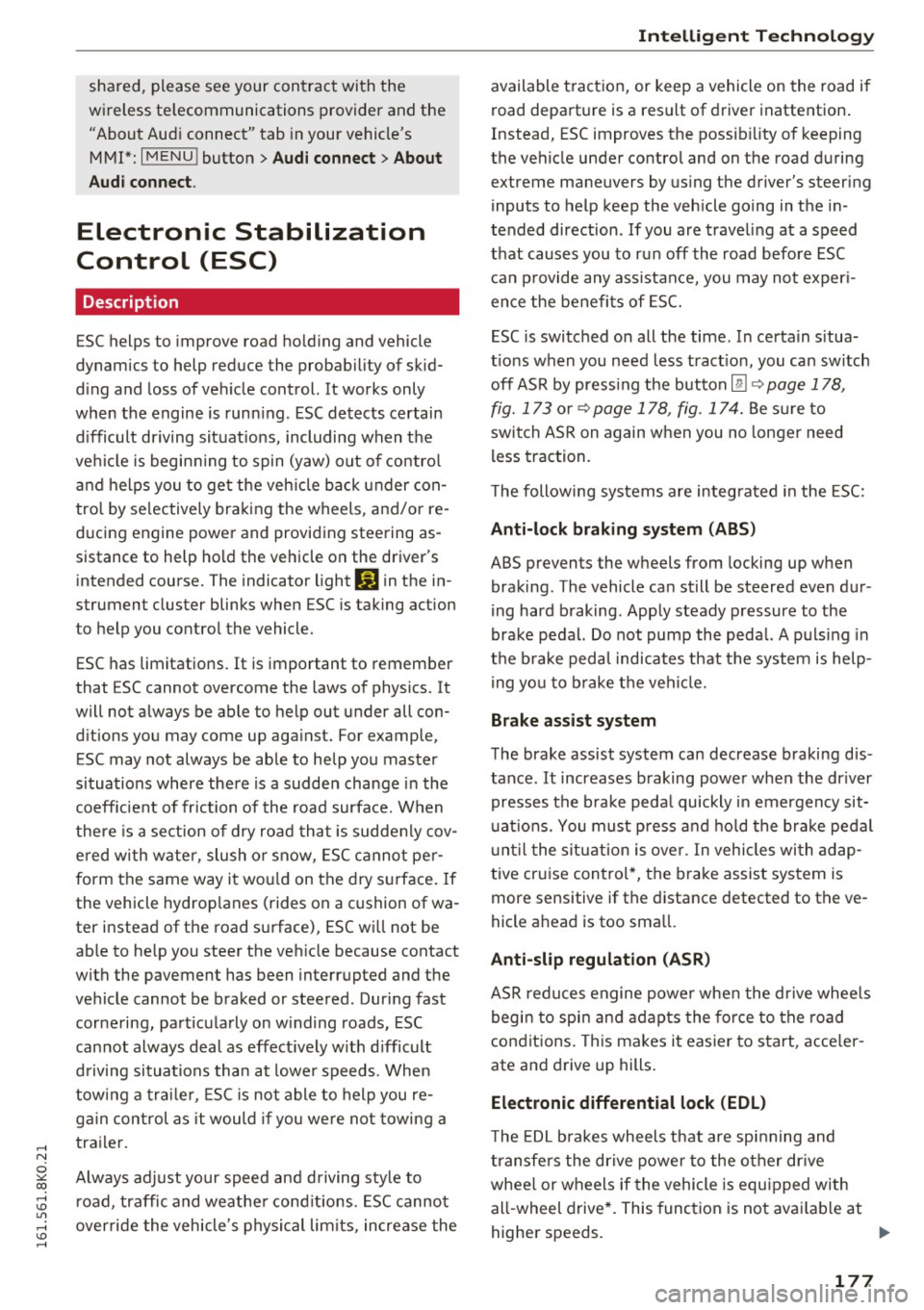
..... N
0 ::..:: co .....
wireless telecommunications provider and the
"About Aud i connect" tab in your vehicle's
MMI*:
IMENU I button> Audi connect > About
Audi conn ect.
Electronic Stabilization
Control (ESC)
Description
ESC helps to improve road ho ld ing and vehicle
dynamics to help reduce the probability of skid
d ing and loss of veh icle control. It works only
when the engine is runn ing . E SC detects certain
d ifficult dr iving sit uat ions, including when t he
ve hicl e is begin ning to spin (yaw) out of co ntro l
a nd helps you to ge t the veh icle back under con
tro l by se lective ly bra king the wheels, and/or re
d ucing engine powe r and provid ing steering as
sistance to help hold the vehicle on the dr iver's
intended course. The indicator light
GJ in the in
strument cluster blinks when ESC is taking action
to help you co ntro l the vehicle.
ESC has limitations. It is important to remember
that ESC cannot overcome the laws of physics. It
will not a lways be able to help out under all con
d itions you may come up aga inst. For example,
ESC may not always be able to help you master
situations where there is a sudde n change in the
coeff icient of friction of the road surface. When
there is a section of dry road that is sudde nly cov
e red with wate r, slush o r snow, ESC cannot pe r
form the same way i t wo uld on the dry s urface . If
the vehicle hydrop lanes (rides on a cushion of wa
ter i nstead of t he road su rface), ESC wi ll not be
ab le to he lp you steer the ve hicle because contact
with the pavement has been interrupted and the
ve hicle cannot be b raked or steered. Dur ing fast
cornering, pa rticula rly on w inding roads, ESC
cannot always deal as effect ively w it h difficult
d riving si tuations tha n at lowe r speeds. When
tow ing a t raile r, ESC is no t able to help you re
g ai n con trol as it would if you we re not towing a
tra iler .
A lways adjust yo ur speed and driving sty le to
road, traffic and weathe r co nd itions. ESC canno t
override the vehicle's physical lim its, increase the
Intellig ent Technology
available t ract ion, or keep a vehicle on the road if
road depart ure is a resu lt of driver inattention .
Instead, ESC improves the possib ility o f keeping
the vehicle under contro l and on the road d uring
extreme maneuvers by us ing the driver's steer ing
i nputs to help keep the veh icle go ing in the in
tended direction.
If you are traveling at a speed
that causes you to run off the road before ESC
c an p rovide any assistan ce, you may not exper i
en ce the benefi ts of ESC.
ESC is swi tched o n all the time . In certa in s itua
t ions when you need less tract ion, you can sw itch
off AS R by press ing the button
11) c:> page 178,
fig. 173 o r c:> page 178, fig . 174. Be s ure to
swi tch ASR on again w hen you no longe r need
l ess trac tion.
T he following systems are integ ra ted in the ESC:
Anti-lock brak ing system (ABS)
ABS prevents the wheels from locking up w hen
braking. The vehicle can still be steered even d ur
i ng hard braking. Apply steady p ressure to the
brake pedal. Do not pump the peda l. A p uls ing in
t h e br ake peda l indicates that the system is help
i ng yo u to b rake the vehi cle.
Brake assist system
T he brake assist system can decrease braking dis
tance . It increases b raking powe r when the dr iver
presses the b rake peda l quickly in emergency sit
u at io ns. You mus t press and ho ld the br ake pedal
u nt il t he s ituat ion is ove r. In vehicles wi th adap
tive cru ise control *, the brake assist system is
more sensitive if the distance detected to the ve
hicle ahead is too sma ll.
Anti-slip regulation (ASR )
ASR reduces engine powe r whe n the dr ive whee ls
begi n to spin and adapts the fo rce to the road
co ndit ions . Thi s makes it easier to start, acce ler
ate and d rive up hills .
Electronic differential lock (EDL)
T he ED L brakes wheels t hat are spi nning and
transfe rs the dr ive power to the o ther dr ive
whee l or wheels if the vehicle is equ ip p ed with
all -wheel drive*. This function is not ava ilab le at
higher speeds. .,.
177
Page 180 of 278
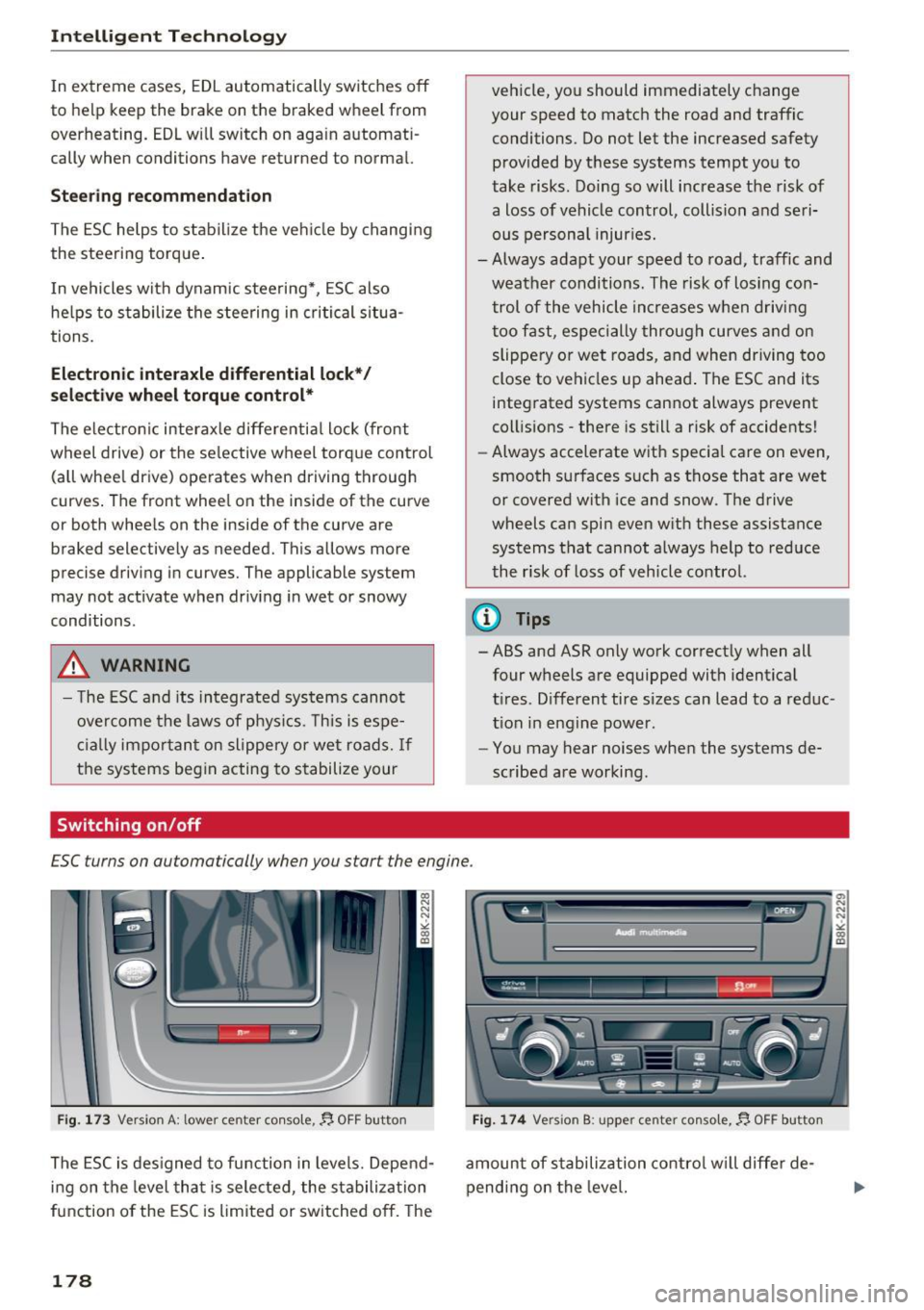
Inte llig ent Techn olo gy
In extreme cases, EDL automatically switches off
to help keep the brake on the braked wheel from
overheating. EDL will switch on aga in automati
cally when conditions have returned to normal.
St eer ing r ecomm endation
The ESC helps to stabilize the vehicle by chang ing
the steering torque .
I n vehicles with dynamic steering*, ESC also
helps to stabilize the stee ring in critical situa
tions.
Electron ic inter axle differential lock*/
sel ective whe el t orque control *
The electronic interaxle differentia l lock (front
wheel drive) or the selective wheel torque control
(a ll whee l drive) operates when driving through
curves . The front wheel on the inside of the curve
or both wheels on the inside of the curve are
braked selectively as needed. This allows more
precise driving in curves. The applicable system
may not activate when driving in wet or snowy
conditions.
.,&. WARNING
- The ESC and its in tegrated systems canno t
overcome the laws of phys ics. This is espe
c ially important on slippery or wet roads.
If
the systems begin acting to stabilize your
Switching on /off
vehicle, you should immediately change
your speed to match the road and traffic
conditions. Do not let the increased safety
provided by these systems tempt you to
take risks. Doing so will increase the risk of
a loss of vehicle control, collision and seri
ous personal injuries.
- Always adapt your speed to road, traffic and
weather conditions. The risk of los ing con
trol of the vehicle increases when driving
too fast, espec ially through curves and on
slippery o r wet roads, and when driving too
close to vehicles up ahead . The ESC and its
integrated systems cannot always prevent
collisions -there is still a risk of accidents!
- Always accelerate with specia l care on even,
smooth surfaces such as those that are wet
or covered with ice and snow. The drive
wheels can spin even with these assistance
systems that cannot always help to reduce
the risk of loss of vehicle control.
@ Tips
- ABS and ASR only work correct ly when all
four wheels are equipped with identical
t ires. Different tire sizes can lead to a reduc
t ion in engine power.
- You may hear noises when the systems de
scribed are working.
ESC turns on automatically when you start the engine .
Fig. 173 Version A: lower center console,~ OFF button
The ESC is des igned to function in levels. Depend
i n g on the level tha t is selected, the stabilization
function of the ESC is limited or switched off. The
178
Fig. 174 Version B: upper center console,~ OFF button
amount of stabilization contro l w ill diffe r de
pending on the level.
"' N N N ~ 0:, m
Page 183 of 278
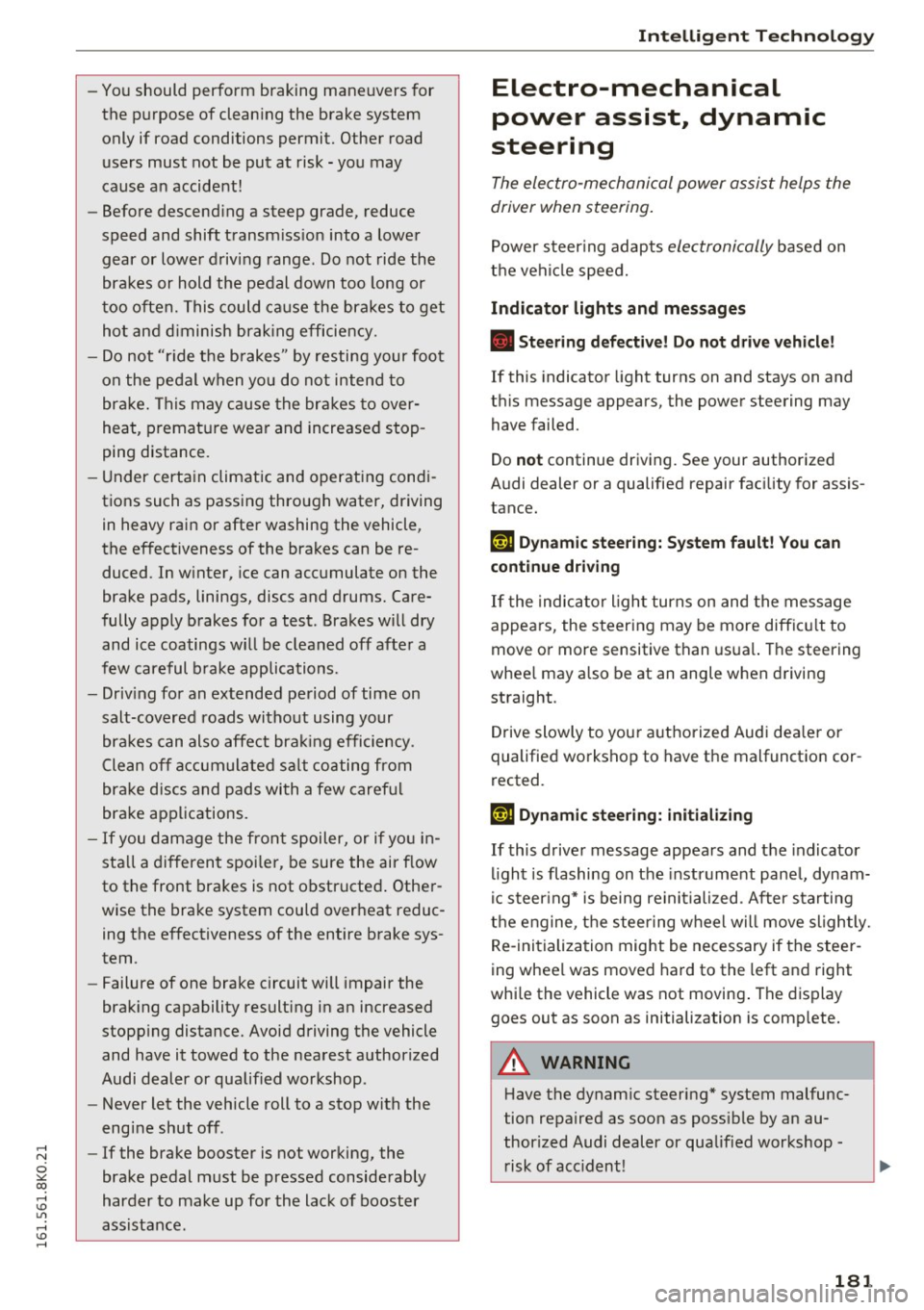
..... N
0 ::..:: co .....
the p urpose of clean ing the brake system
only if road conditions permit. Other road
users must not be put at risk - you may
cause an accident!
- Before descend ing a steep grade, reduce
speed and shift transm iss io n into a lower
gear or lowe r d riv ing range. Do not ride the
bra kes or hold the pedal down too long or
t oo often. This could ca use the bra kes to get
hot an d diminish brak ing efficiency.
- Do not "r ide t he b rakes" by resting your foot
on the pe dal when yo u do not inten d to
br ak e. This may cause the br akes to over
heat, p remat ure wea r and increased stop
ping distance.
- Under certa in climatic and operating condi
tions such as passing thro ugh water, driving
in heavy ra in or after washing the vehicle,
the effectiveness of the brakes can be re
duced. In w inte r, ice can acc umulate on the
brake pads, linings, discs and drums. Care
fully apply brakes for a test. Brakes will dry and ice coatings w ill be cleaned off after a
few careful b rake applica tions.
- Driv ing for an ex tended period of time on
salt-covered roads witho ut using your
bra kes can also affe ct bra king efficie ncy .
C le an off a ccumula ted s alt co ating from
bra ke discs and pads with a few caref ul
bra ke app lications.
- If you dam age the fro nt sp oiler, or if yo u in
st all a diff erent spoi le r, be sure the ai r flow
to the front brakes is not obstr ucte d. Othe r
wise the bra ke system could overheat reduc
ing the e ffectiveness of the entire b rake sys
tem.
- Failure of one brake circuit will impair the
brak ing capability resulting in an increased
stopp ing distance. Avoid driving the vehicle
and have it towed to the nearest authorized
Audi dealer or qualif ied workshop.
- Never let the veh icle roll to a stop w ith the
engi ne shut off .
-If the brake booster is not working, the
bra ke pedal m ust be pressed conside rably
harder to make up for the lac k of booster
assista nee .
Intellig ent Technology
Electro-mechanical
power assist, dynamic
steering
The ele ctro-mechanical power a ssist helps the
driver when steering .
P ower s teer ing adapts electronically based on
t h e veh icle spee d.
Indicator lights and messages
• Steering defective! Do not drive vehicle!
If this indicator light turns on and stays on and
t hi s message appears, the power steering may
have failed.
Do
not continue driving. See your author ized
Audi dealer or a qualified repair facility for assis
tance.
' :r, y Dynamic steering: System fault! You can
continue d riving
If the indic ator l igh t turns on and the message
appe ars, the steering may be more diffic ult to
move o r more sensitive than usu a l. T he steering
whee l may a lso be at an angle w hen d riving
straight .
Drive slowly to you r autho rized Audi dea le r or
qualified wo rks hop to have the malfunction cor
rected .
,T u Dynamic steering: initializing
If this drive r message appea rs and t he indicator
li ght is flashing on t he instrument pane l, dynam
ic s teer ing* is being re ini tialized. After s tarting
t h e engine, t he steer ing w heel w ill move sligh tly.
Re- ini tializa tion might be necessary if the s teer
ing wheel was moved hard to the left a nd right
whi le the vehicle was not moving . The display
goes out as soon as initialization is comp lete.
A WARNING ~
Have the dynam ic steeri ng* system malfunc -
tion repaired as soon as poss ible by an au
thor ized Audi dealer or qualified workshop -
r isk of acc ident!
181
Page 184 of 278
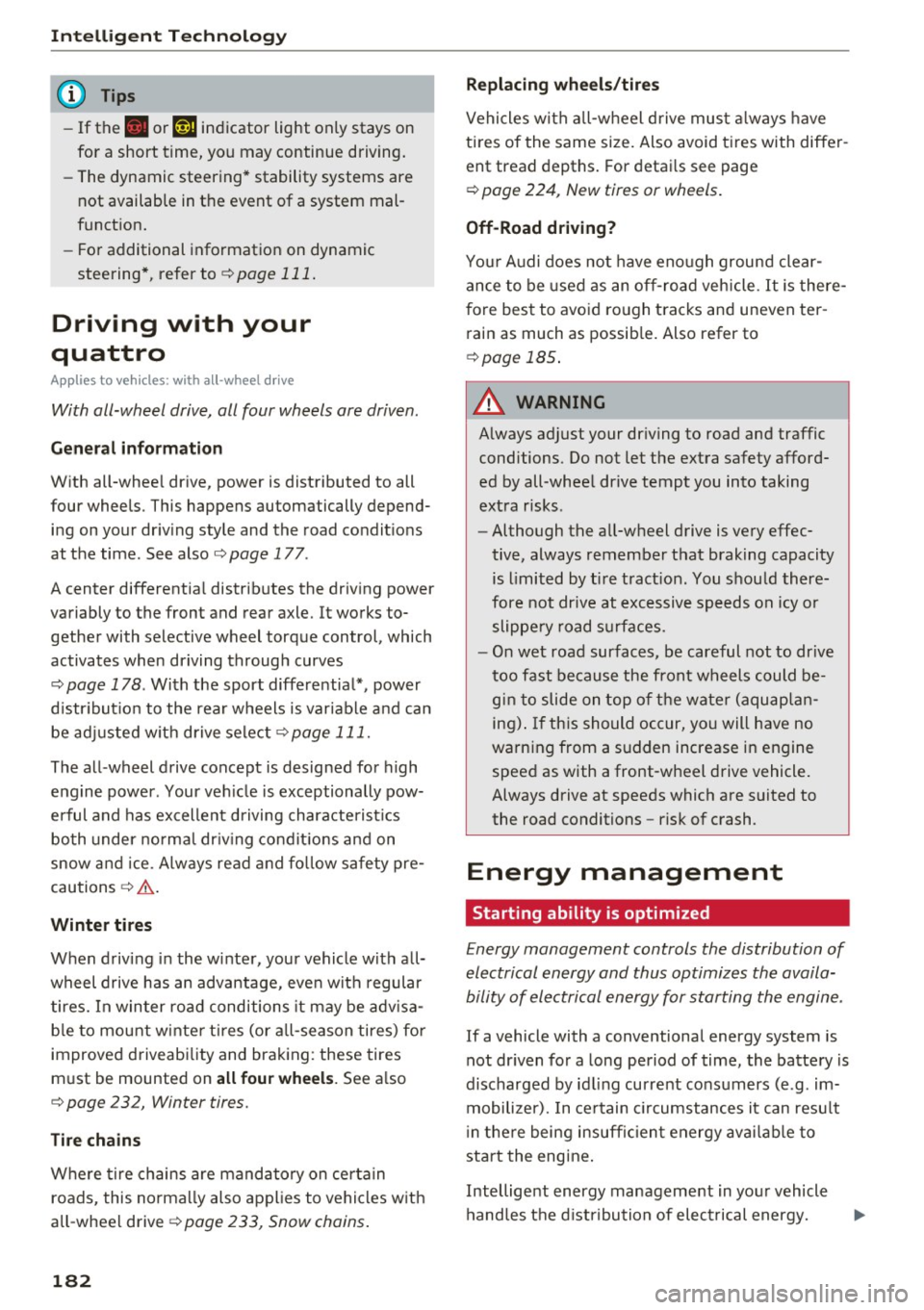
Intelligent Technology
(D Tips
- If the . or
,~ n ind icator light only stays on
fo r a short time, you may continue driving.
- The dynamic steering* stability systems are
not available in the event of a system mal
funct ion.
- Fo r additional information on dynamic
steering*, refer to¢
page 111 .
Driving with your
quattro
Applies to veh icles: w ith all-wheel drive
With all-wheel drive, all four wheels are driven.
General information
With all-whee l drive, power is distributed to all
four wheels . This happens automatically depend
ing on your dr iv ing style and the road condit ions
at the time . See also ¢
page 177 .
A center differentia l distrib utes the driv ing power
variably to the front and rear axle. It works to gether with selective wheel torque control, which
activates when driving through curves
¢
page 178 . With the sport differentia l*, power
d istr ibut io n to the rear wheels is variable and can
be adj usted w ith d rive select¢
page 111.
The all -wheel drive concept is designed for high
engine power . Your veh icle is exceptionally pow
erful and has excellent driving characterist ics
both under normal dr iv ing condit io ns and on
snow and ice. Always read and fo llow safety pre
cautions ¢
A.
Winter tires
When d rivi ng in the winter, your vehicle with all
wheel drive has an advantage, eve n with regular
tires. In winter road conditions it may be adv isa
b le to mount w inte r ti res (or all-season tires) fo r
improved driveability and braking: these tires
must be mounted on all four wheels . See a lso
¢ page 232, Winter tires.
Tire chains
Where ti re chains are mandatory on certain
roads, this norma lly also applies to vehicles w ith
all -whee l drive ¢
page 233, Snow chains .
182
Replacing wheels /tires
Vehicles with all-wheel d rive must a lways have
tires of the same size. Also avoid t ires with differ
ent tread depths. For detai ls see page
¢ page 224, New tires or wheels .
Off-Road driving?
You r A udi does not have eno ugh ground clear
an ce to be used as an off-road vehicle.
It is there
fore best to avoid ro ugh tracks and uneven ter
rain as much as possib le. Also refer to
¢ page 185.
A WARNING
A lways adjust your dr iving to road and traffic
conditions . Do not let the extra safety afford
ed by all-whee l drive tempt you into taking
extra risks .
- Although the all-wheel drive is very effec
tive, always remember that braking capacity
is limited by ti re tract ion. You s hou ld there
fore not drive at excessive speeds on icy or
slippe ry road s urfaces.
- On wet road surfaces, be careful not to dr ive
too fast because the front wheels could be
gi n to slide on top of the water (aquaplan
ing) . If th is should occur, you will have no
warning from a s udden increase in engine
speed as with a front-wheel drive vehicle.
Always drive at speeds which are suited to
the road conditions -risk of crash .
Energy management
Starting ability is optimized
Energy management controls the distribution of
electrical energy and thus optimizes the availa
bility of electrical energy for starting the engine .
If a vehicle with a conventional energy system is
not driven for a long period of time, the batte ry is
discharged by id ling current consumers (e.g . im
mobilizer). In ce rtain circumstances it can resu lt
i n the re being insufficient energy avai lab le to
start the engine .
Intelligent energy management in yo ur vehicle
hand les t he d istribution of elect rical energy. .,.
Page 185 of 278

..... N
0 ::..:: co .....
of the battery is extended.
Basically, energy management consists of
bat
t e ry di agno sis, idl ing curr ent mana gement
and
dy namic en ergy management .
Battery diagnosis
Battery diagnosis continuous ly determines the
state of the batte ry . Sensors dete rm ine battery
voltage, batte ry current and battery tempera
ture . This determ ines the current state of charge
and the power of the battery.
Idling current management
Idling current management reduces energy con
sumpt io n while the veh icle is stand ing . With the
i gn it ion sw itched off, it controls the energy sup
p ly to the various ele ctrical components . Data
from battery diagnosis is considered.
D epending on the battery's state of charge, ind i
vid ual consume rs a re gradually turned off to p re
vent excessive discharge of the battery and thus
maintain starting capability.
Dynam ic energy management
While the vehicle is being driven, dynamic energy
management dist ributes the ene rgy generated
accord ing to the needs of the individual compo
nents . It regulates cons umption, so that mo re
e lectrica l energy is not being used than is being
generated and ensures an optimal state of
charge for the battery.
@ Tips
- But even energy management cannot neg
ate the limits of physics. Consider that the power and life of a battery are limited.
- If starting ability is threatened, the indica
tor light
(•j appears 9 page 16.
What you should know
The highest priority is given to maintaining start
ing capability.
The ba tte ry is severely taxed in short -d istance
driving, in city traffic and d uring the co ld time of
year. Abundant electrical energy is requ ired, but
Intellig ent Technology
on ly a little is generated . It is a lso critical if the
engine is not running and electrical components
are turned on. In this instance energy is being
consumed but none is being generated.
It is in precisely these situations that you will no
tice energy management actively regulating the distribution of energy .
Vehicle stands for an extended period
If you do no t drive your vehicle ove r a period of
severa l days o r weeks, electrical components are
gradually cut back or switched off. This reduces
energy consumption and maintains starting ca
pability over a longer period. Some of the con
venience functions may not operate, such as the interior lights or the power seat adjustment. The
convenience functions will be ava ilable aga in
when you switch on the ignition and start the en
gine.
With the engine turned off
If you listen to the rad io, for example, with the
engine turned off or use other MMI funct ions,
the battery is being d ischarged .
If starting capab ility is jeopardized due to energy
consumption, a message appears in the MMI dis
play . The message ind icates that the system will
be switched off automat ica lly in a moment . If
you w ish to continue using the funct ions, you
have to sta rt the eng ine.
With the engine running
Although e lectr ical energy is generated when the
vehicle is being driven, the battery can become
discharged. This happens mostly when little en
ergy is being generated and a great dea l con
s u med and the batte ry's state of charge is not
optimal.
T o bring the energy balance back into equilibr i-
um, consumers w hich require espec ia lly large
amounts of ene rgy are tempo rar ily cut back o r
swi tched off . Hea ting systems in particular re-
quire a great de al of energy. If yo u no tice, fo r ex
amp le, that the heated seats * or the heated rear
window are not heating, they have been tempo
rarily cut bac k or switched off. These systems will .,..
183
Page 186 of 278

Intelligent Technology
be ava ilab le aga in as soon as the energy balance
has been restored.
You will a lso not ice tha t engine idle speed has
been inc reased slightly. This is normal and not a
cause for concern. By increasing eng ine idle
speed the additiona l energy required is generat
ed and the battery is cha rged .
184
Page 187 of 278
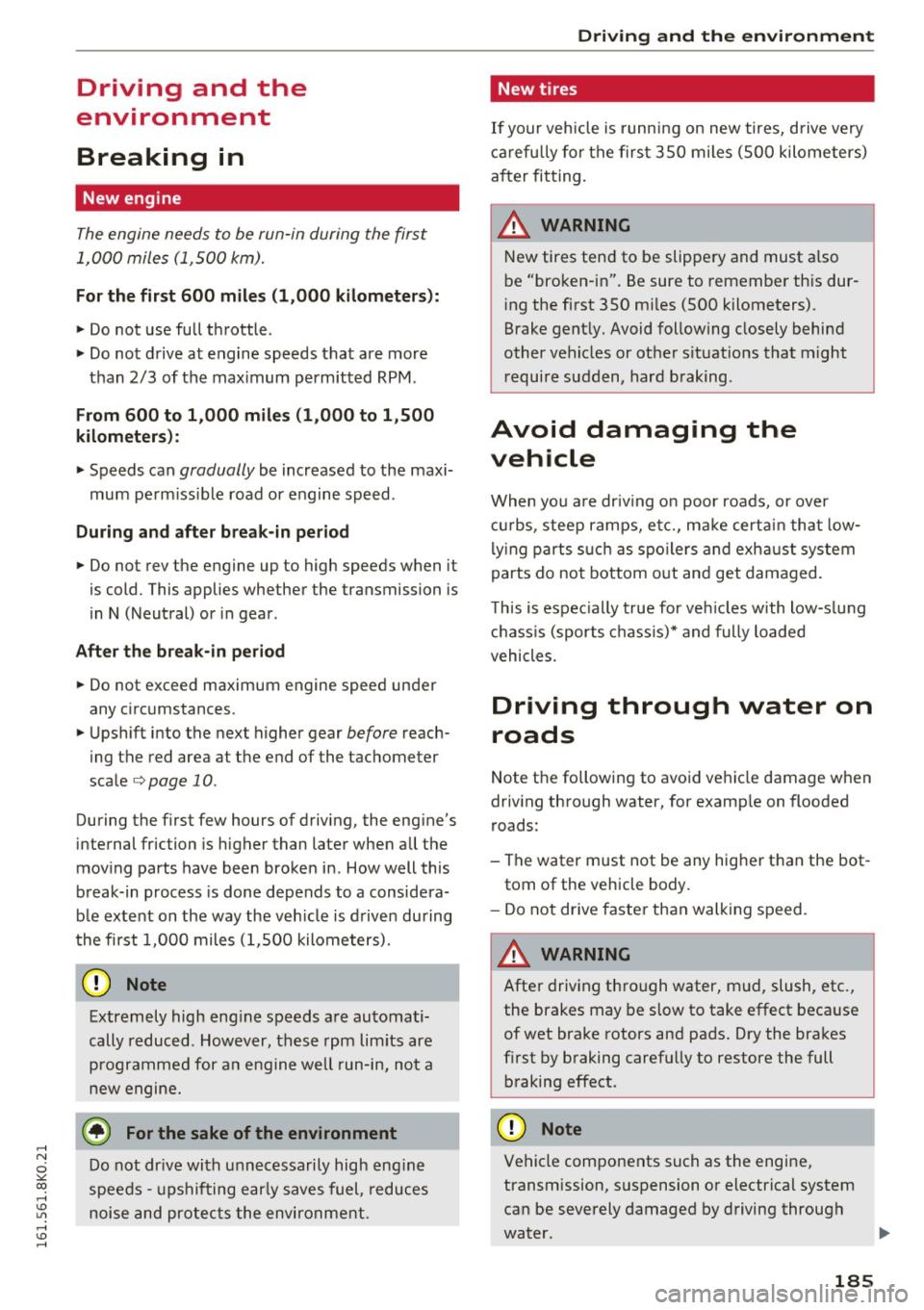
..... N
0 ::..:: co .....
environment
Breaking in
New engine
The engine needs to be run-in during the first
1,000 miles (1,500 km).
For the first 600 miles (1 ,000 kilometer s):
"' Do not use full throttle .
"' Do not drive at engine speeds that are more
than
2/3 of the max imum permitted RPM .
From 600 to 1,000 miles (1 ,000 to 1 ,500
kilometers):
"' Speeds can gradually be increased to the maxi
mum pe rm issib le road or engine speed .
During and after break-in pe riod
"' Do not rev the engine up to high speeds when it
is cold. This applies whether the transmission is
in N (Neutral) or in gear .
After the break-in period
"'Do not exceed maximum engine speed under
any c ircumstances.
"'U pshift into the next higher gear
before reach
ing the red area at the end of the tachometer
sca le
c=>page 10.
During the first few hours of driving, the eng ine's
internal friction is higher than later when all the
mov ing parts have been broken in . How well this
b reak-in process is done depends to a considera
b le exte nt on the way the veh icle is d rive n during
t he first 1,000 miles (1,500 kilometers).
(D Note
Extremely high eng ine speeds a re au toma ti
cally reduced. However, these rpm limits are
programme d for a n engine well run-in, not a
new engine.
@) For the sake of the environment
D o not dr ive with u nnecessari ly high eng in e
spee ds -ups hifting ea rly saves fuel, reduces
noise and pro tec ts the envi ronme nt.
Driving and the envir onment
New tires
If your vehicle is runn ing on new tires, d rive very
car efu lly fo r the firs t 35 0 miles (500 kilometers)
a ft er fit ting.
New tires tend to be slippe ry and must a lso
be "bro ken-in". Be sure to remembe r th is dur
i ng the fi rst 350 m iles (500 kilometers).
Brake gent ly. Avoid following closely behind
other vehicles or other s ituations that m ight
r equire sudden, hard b raking.
Avoid damaging the
vehicle
When yo u are dr iv ing o n poor roa ds, or over
cur bs, stee p ramps, e tc., ma ke cert ain that low
ly ing parts s uch a s spo ile rs a nd exh aust sy stem
parts do no t bottom o ut and get dama ged.
T his is espec ially true for ve hicles with low-s lung
c h ass is (sports c hass is) * and fully loaded
vehicles.
Driving through water on
roads
Note t he following to avoi d ve hicle damage w hen
driv ing through water, for examp le on flooded
roads:
- The water must not be any hig her t han the bot
tom of the vehicle body.
- Do not dr ive faste r than walk ing speed.
A WARNING
= -
Afte r driv ing th ro ugh water, m ud, slush, etc .,
the brakes may be slow to take effect beca use
of wet brake rotors and pa ds. Dry the brakes
f irst by braking carefully to restore the full
b raking effect.
(D Note
Ve hicle compone nts such as the engine,
transmission, suspension o r electrica l system
can be severely damaged by driving throug h
water.
185
Page 188 of 278
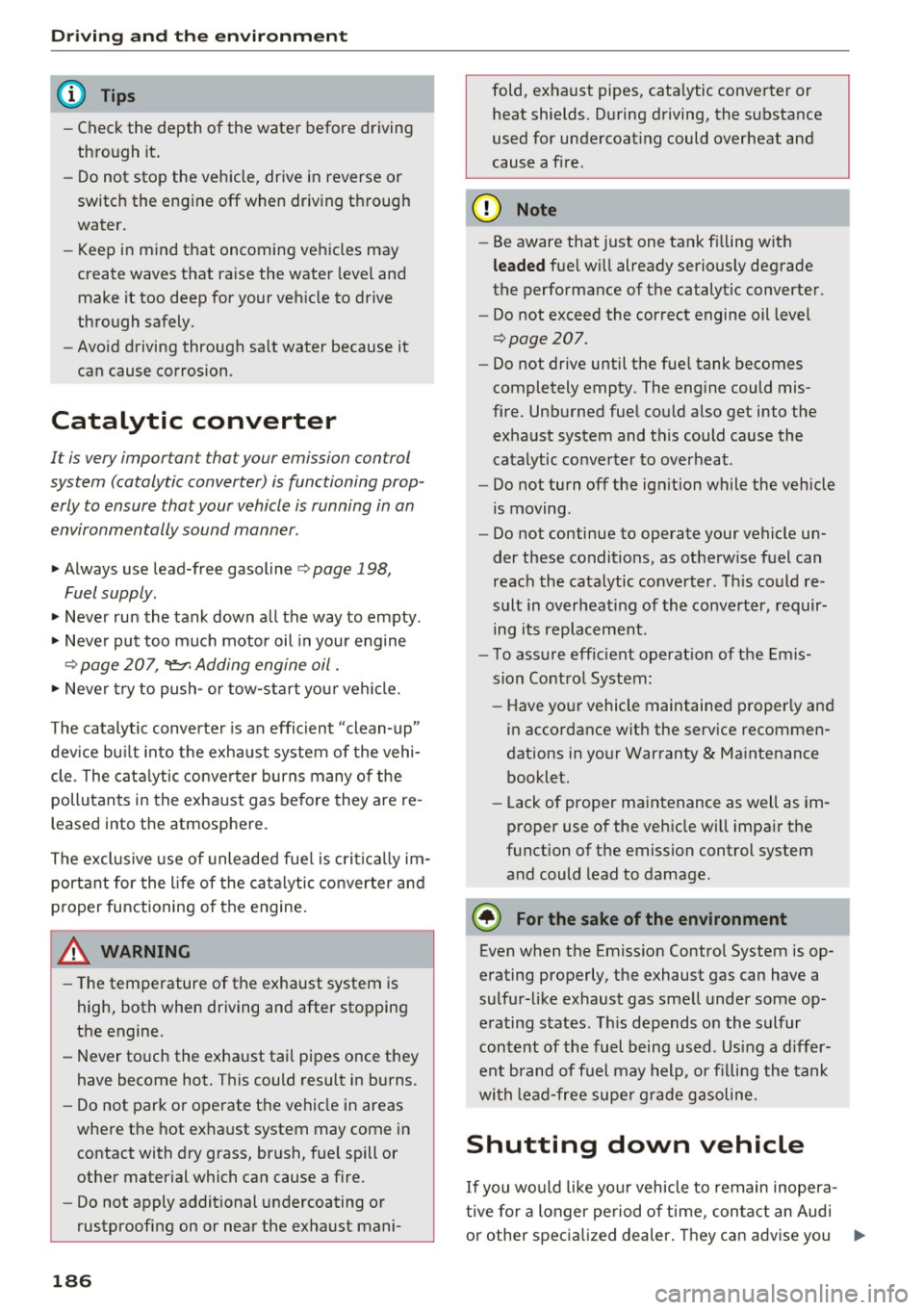
Driving and th e en vironm ent
(D Tips
- Check the depth of the water before driving
through it .
- Do not stop the veh icle, drive in reverse or
switch the engine
off when driving through
water.
- Keep in mind that oncoming vehicles may
create waves that raise the water level and
make it too deep for your veh icle to drive
through safely.
- Avoid driving through salt water because it
can cause corrosion .
Catalytic converter
It is very impor tant tha t your emission con trol
system (ca talytic converter) is functioning prop
erly to ensure that your vehicle is running in an
environmentally sound manner .
~ Always use lead-free gasoline ¢ page 198,
Fuel supply .
~ Never run the tank down a ll the way to empty .
~ Never put too much motor oil in your engine
¢ page 20 7, 9::?l Adding engine oil .
~ Never try to push- or tow-start you r vehicle.
The cata lytic converter is an efficient "clean-up"
dev ice bu ilt into the exha ust system of the vehi
cle. The cata lytic conve rter burns many of the
pollutants in the exhaust gas before they are re
leased into the atmosphere.
The exclusive use of unleaded fue l is critica lly im
portant for the life of the catalytic conve rter and
p roper functioning of the engine.
A WARNING ,..____ -
- The temperature of the exhaust system is
high, both when driving and after stopping
the engine.
- Never touch the exha ust tail pipes once they
have become hot. This could result in burns.
- Do not park or ope rate t he vehicle in areas
where t he hot exha ust system may come in
contact with dry grass, br ush, fue l spill or
other mater ial which can cause a fire.
- Do not apply additional undercoating or
rustproofing on or near the exhaust mani-
186
fold, exha ust pipes, cata lytic conve rter or
heat shields . D uring driving, the substance
used for undercoat ing could overheat and
cause a f ire .
Cl) Note
-Be aware that just one tank f illing wit h
leaded fu e l w ill already seriously degrade
the performance of the catalytic converter.
- Do not exceed the correct engine oil leve l
¢page 207.
-Do not drive until the fue l tank becomes
completely empty . The engine could mis
fire. Unbu rned fue l cou ld also get into the
exhaust system and this could cause the
catalytic converter to overheat.
- Do not turn off the ign ition while the vehicle
is moving .
- Do not continue to operate your vehicle un
der these conditions, as otherw ise fuel can
reac h the catalytic converter . T hi s could re
sult in overheat ing of the converter, requir
ing its replacement.
- T o ass ure eff icient ope rat ion of the Emis
sion Contro l System:
- Have you r vehicle maintained properly and
i n accordance wit h the service recommen
dations in your Warranty & Ma intenance
booklet.
- Lack of proper ma intenance as well as im
p roper use of the veh icle will impa ir the
function of the emission control system
and could lead to damage .
(® For the sake of the environment
Even when the Emission Control System is op
erating properly, t he exhaust gas can have a
sulfur-like exhaust gas smell under some op
erating states. Th is depends on the sulfur
con tent of the fuel being used . Us ing a d iffer
ent brand of fuel may help , or fi lli ng the tank
wi th lead-free super g rade g asoline.
Shutting down vehicle
If you wo uld like yo ur vehicle to remain inopera
tive for a longer pe riod of time, con tact an Audi
o r other spec ia liz ed dealer. They can adv ise you ..,.